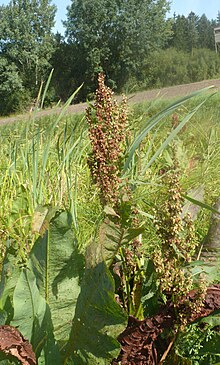River dock
| River dock | ||||||||||||
|---|---|---|---|---|---|---|---|---|---|---|---|---|

River dock ( Rumex hydrolapathum ) |
||||||||||||
| Systematics | ||||||||||||
|
||||||||||||
| Scientific name | ||||||||||||
| Rumex hydrolapathum | ||||||||||||
| Huds. |
The river dock ( Rumex hydrolapathum ), also called pond dock or giant dock , belongs to the genus dock ( Rumex ) from the knotweed family (Polygonaceae).
description
They are perennial herbaceous plants that reach heights of between 0.8 and 2.5 m and are therefore among the largest species of dock. The " root stock " is strong and multi-headed, it is black and forms a flat bulge. The up to 80 cm long, lanceolate basal leaves are narrowed into the petiole at the base. In the middle of the leaf, the lateral nerves branch off from the midrib more or less at right angles. The leaves are finely curled at the edge and dark green. They are long-stalked. The secondary leaf sheaths are short and notched.
The stems , from which several can arise from each leaf rosette, usually branch only in the area of the inflorescence , which is relatively densely covered with whorls and takes up about a third of the length of the stem . The 5 to 7 mm long, imperforate blades are triangular. They are each covered with a callus that is two to three times as long as it is wide. The valve base is slightly wedge-shaped or straight, but not heart-shaped like the similar blunt-leaved dock ( Rumex obtusifolius ). The species blooms reddish from July to August. It then forms 3 to 5 mm long, top broad, top-shaped, brown nut fruits .
The number of chromosomes is 2n = 200.
Occurrence
The river dock grows in the silting area of lakes or rivers or in ditches, even in shallow water. On wet to very wet, often flooded, moderately to nutrient-rich, muddy or silty, gravel, sandy or silty soils. The typical place of growth is the immediate shoreline, where the species inserts itself between the water surface and the reed belt.
The species often grows with eutraphent reed species such as water plumes ( Glyceria maxima ), branched hedgehog ( Sparganium erectum ), calamus ( Acorus calamus ) and broad-leaved cattail ( Typha latifolia ). In Central Europe it is a species of the order Phragmitetalia.
This species is originally only found in Europe and Turkey. The southwest border extends on the northern edge of the Pyrenees . The eastern border is formed by the Volga . The northern limit extends to a maximum of 62 degrees north latitude. In the south the distribution area ends in the Po Valley , in the northern Balkan Peninsula and on the northern Black Sea coast . In South America there are neophytic occurrences.
Systematics
According to herbarium evidence, the species forms natural hybrids with the water dock ( Rumex aquaticus ) . The bastard is not uncommon in areas where both species are found. In habit it is more similar to the river dock, but differs in the base leaves trimmed at the base or heart-shaped on one or both sides and lower stem leaves.
River dock and man
The existence of the river Ampfers has declined sharply due to canals and river barriers. Regionally, the species declined significantly in the 20th century and is considered to be in need of care.
Plant parts contain abundant oxalic acid , which in large quantities is harmful to human health, especially to those with kidney disease. After cooking, however, the content of oxalic acid is noticeably reduced and the plant can be eaten prepared similar to spinach . The dried seeds are crushed and used as a spice.
The species (like other dock species) has medicinal benefits; the root helps relieve stomach upsets and diarrhea. Applied leaves help against ulcers in the eye area. A plant that can be interpreted as river dock or water dock , lapatium , was used in antiquity against ulcers on the groin.
Sources and further information
literature
- Henning Haeupler , Thomas Muer: picture atlas of the fern and flowering plants of Germany (= the fern and flowering plants of Germany. Volume 2). Published by the Federal Agency for Nature Conservation. Ulmer, Stuttgart 2000, ISBN 3-8001-3364-4 .
- Werner Rothmaler : Excursion flora for the areas of the GDR and the FRG . 14th edition. tape 2 : vascular plants. People and knowledge, Berlin 1988, ISBN 3-06-012539-2 .
- Oskar Sebald, Siegmund Seybold, Georg Philippi (Hrsg.): The fern and flowering plants of Baden-Württemberg . tape 1 : Special part (Pteriophyta, Spermatophyta) Lycopodiaceae to Plumbaginaceae. Ulmer, Stuttgart 1992, ISBN 3-8001-3322-9 , pp. 556-559 .
Web links
- River dock. In: FloraWeb.de.
- Distribution map for Germany. In: Floraweb .
- Rumex hydrolapathum Huds. In: Info Flora , the national data and information center for Swiss flora . Retrieved October 5, 2015.
- Distribution in the northern hemisphere according to: Eric Hultén , Magnus Fries: Atlas of North European vascular plants 1986, ISBN 3-87429-263-0
- Thomas Meyer: Data sheet with identification key and photos at Flora-de: Flora von Deutschland (old name of the website: Flowers in Swabia )
- Entry in the Plants for a Future Database (in English )
- biopix.dk: images
Individual evidence
- ↑ a b Erich Oberdorfer : Plant-sociological excursion flora for Germany and neighboring areas . 8th edition. Verlag Eugen Ulmer, Stuttgart 2001, ISBN 3-8001-3131-5 . Page 330.
- ^ A b Rumex in the Germplasm Resources Information Network (GRIN), USDA , ARS , National Genetic Resources Program. National Germplasm Resources Laboratory, Beltsville, Maryland. Retrieved August 17, 2017.
- ↑ Hans Zotter : Ancient medicine. The collective medical manuscript Cod. Vindobonensis 93 in Latin and German. Academic printing and Verlagsanstalt, Graz 1980 (= Interpretationes ad codices. Volume 2); 2nd, improved edition, ibid. 1986, ISBN 3-201-01310-2 , pp. 76-79.
